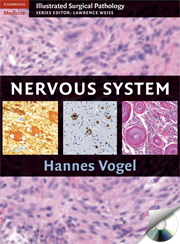Book contents
- Frontmatter
- Contents
- Contributors
- Preface
- Acknowledgments
- 1 Normal Anatomy and Histology of the CNS
- 2 Intraoperative Consultation
- 3 Brain Tumors
- 4 Vascular and Hemorrhagic Lesions
- 5 Infections of the CNS
- 6 Inflammatory Diseases
- 7 Surgical Neuropathology of Epilepsy
- 8 Cytopathology of Cerebrospinal Fluid
- Index
5 - Infections of the CNS
Published online by Cambridge University Press: 04 August 2010
- Frontmatter
- Contents
- Contributors
- Preface
- Acknowledgments
- 1 Normal Anatomy and Histology of the CNS
- 2 Intraoperative Consultation
- 3 Brain Tumors
- 4 Vascular and Hemorrhagic Lesions
- 5 Infections of the CNS
- 6 Inflammatory Diseases
- 7 Surgical Neuropathology of Epilepsy
- 8 Cytopathology of Cerebrospinal Fluid
- Index
Summary
Almost any infectious process may involve the brain, its vasculature, cerebrospinal fluid (CSF), or coverings and bony surroundings. This section will describe infectious diseases that are more commonly under consideration through surgical biopsy. The differential diagnosis in many surgical specimens with inflammation involves closely intertwined infectious and noninfectious inflammatory disorders as described in Inflammatory Diseases.
BACTERIAL INFECTIONS
Abscess
Clinical and Radiological Features
Brain abscesses represent the second most common infection of the nervous system after meningitis (Brown and Gray, 2008). Because of advances in radiographic imaging in the proper clinical context, many cases are successfully treated with antibiotics and do not involve biopsy (Bernardini, 2004). In fact, some neuropathologists will encounter brain abscesses more frequently as an unexpected diagnosis when a ring-enhancing tumor constitutes the prebiopsy diagnosis (Figure 5.1).
The usual antecedent predisposing clinical condition involves hematogenous spread of septic emboli, chiefly from bacterial endocarditis, suppurative lung diseases, or in congenital heart diseases with right-to-left shunts, pericranial infections of soft tissue and bone such as sinusitis, otitis media, mastoiditis, and infected dentition. More recently, there has been a decline in the incidence of brain abscesses related to otitis media and congenital heart disease and an increase in examples related to trauma or neurosurgery (Carpenter et al., 2007).
Epidural and subdural abscesses may follow infection of nearby soft tissue or bone. Vertebral epidural abscesses are more common than their intracranial counterparts, and their incidence has increased in the past decade. Spinal epidural abscess is a potentially life-threatening condition that can cause paralysis by the accumulation of purulent material in the epidural space. These lesions are sometimes the consequence of a trivial skin infection.
- Type
- Chapter
- Information
- Nervous System , pp. 401 - 437Publisher: Cambridge University PressPrint publication year: 2009

